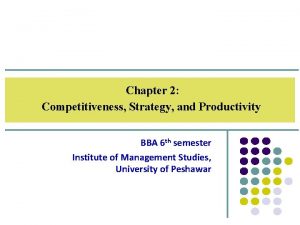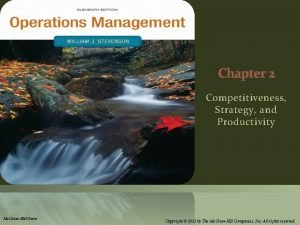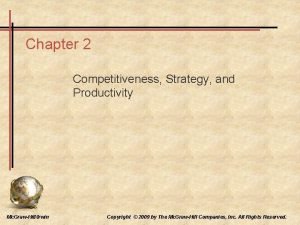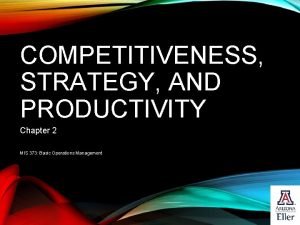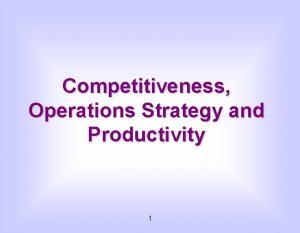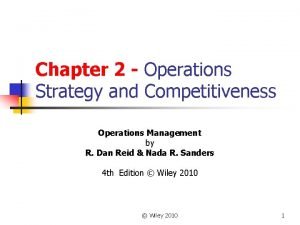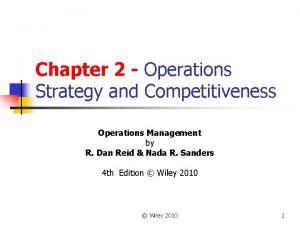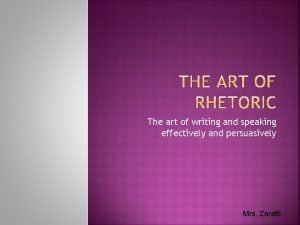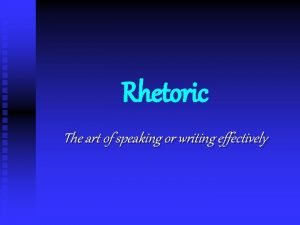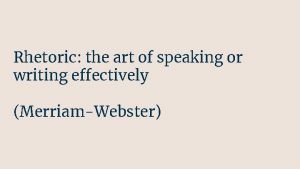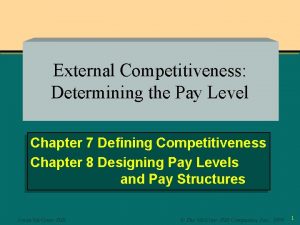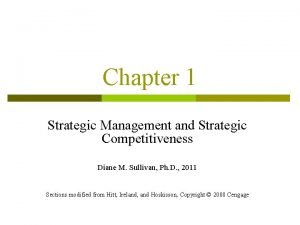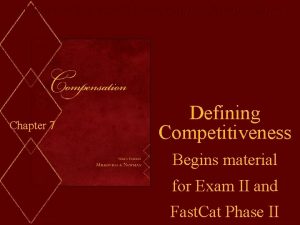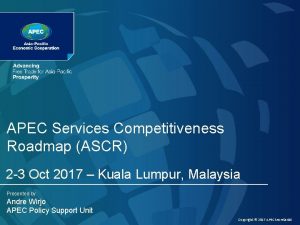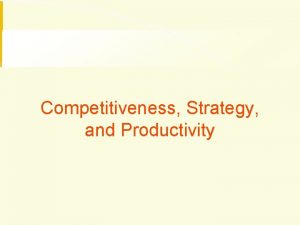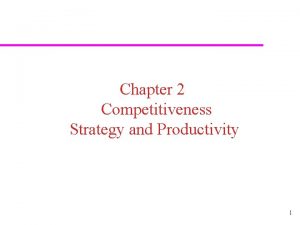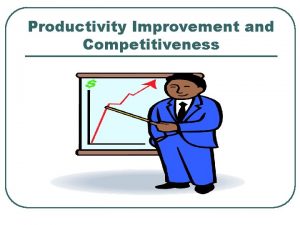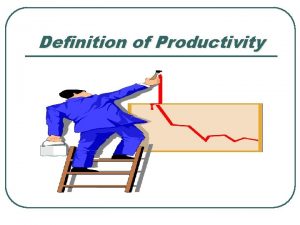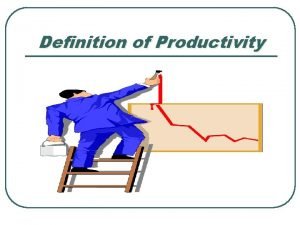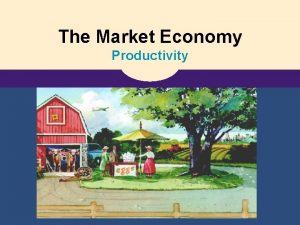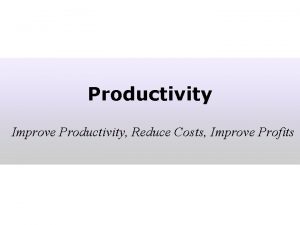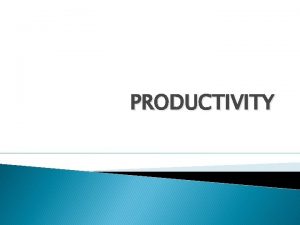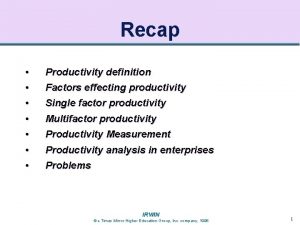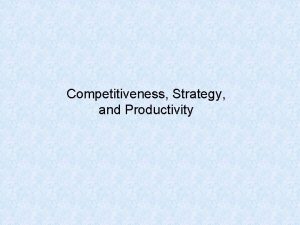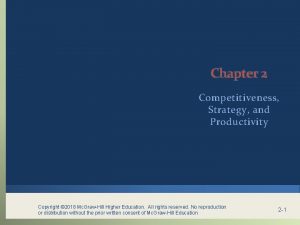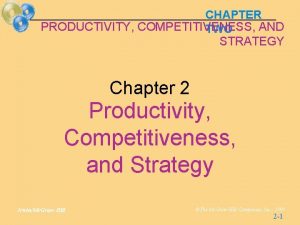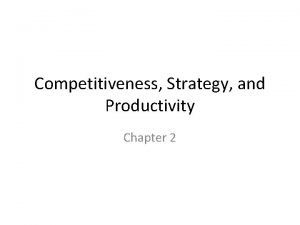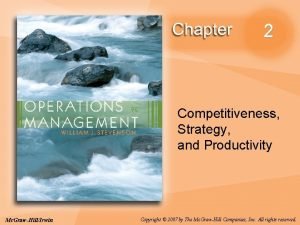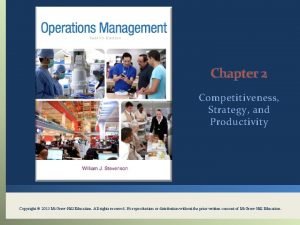Competitiveness Strategy and Productivity Competitiveness How effectively an





















- Slides: 21

Competitiveness, Strategy, and Productivity

Competitiveness How effectively an organization meets, the needs of customers relative to other organisations. Why Some Organizations Fail ? § Failing to consider customer needs § Short-term financial Goals § Failing to establish good internal communications § Failing to develop organisation culture § Failing to take advantage of strengths and opportunities § Too much emphasis in product and service design and not enough on improvement § Neglecting operations strategy § Failing to recognize competitive threats § Neglecting investments in capital and human resources 2 -2

Mission-Strategy-Tactics How does mission, strategies and tactics relate to decision making and distinctive competencies? Decision Making Areas - 2 -3

Mission-Strategy-Tactics § Mission The reason for existence (purpose of an organization) § Goals § Mission Strategy – Provide detail of mission and scope of mission. – Provide the base for strategies and tactics of the functional unit of organisation. Tactics Strategies Plans/ roadmap for achieving organizational goals (long term) § Tactics The methods and actions taken to accomplish strategies (short term) § Operational strategies – Procedure. Must be consistent with organization strategy, it is used to guide the operations function. - This may be related to products, processes, methods, resources, quality, cost, lead time, scheduling, SC, CR, marketing, services.

Planning and Decision Making Figure 2. 1 Mission Goals Organizational Strategies Functional or Dept. Goals Finance Strategies Tactics Operating procedures 2 -5 Marketing Strategies Tactics Operating procedures Operations Strategies Tactics Operating procedures

Operations strategy is narrower in scope, dealing primarily with the operations aspect of the organization. Operations strategy relates to products, processes, methods, operating resources, quality, costs, lead times, scheduling, SC, CR, marketing, services. 2 -6

Some of the strategies various Japanese manufacturing companies have employed since World War II - Ø Low labor cost strategy – after the world war II Ø Scale-based strategy – During the 1960 s, used capital-intensive methods to achieve higher labor productivity and lower unit costs. Ø Focused factories strategy – During 1970 s, use small factories focused on narrow product lines. Specialisation and quality. Ø Flexible factories strategy – During 1980 s, flexible equipment, vol & design changed for variety.

Distinctive Competencies# through Various Operation Strategies* The special attributes or abilities that give an organization a competitive edge. Various distinctive competencies or organisation strategies as shown in diagram (Strategic OM Decisions) # Operations Strategy - used to guide the operations function, must be consistent with the organization strategy. Competitiveness using marketing Ø Identifying consumer wants and needs Ø Pricing (Selling Price) Ø Advertising and promotion Competitiveness using operations strategies

Time-based Strategies JAN FEB MAR APR MAY JUN Planning Designing Processing Changeover Delivery So try to reduce these time elements 2 -9 On time!

Strategy Formulation 1. Distinctive competencies 2. Environmental scanning 3. SWOT Analysis - Strength Weakness (internal), Opportunity Threats (external) Ø Order qualifiers- minm standard of acceptability by customer Ø Order winners – perceived quality better than the competitor. 2 -10

Global Strategy § Strategic decisions must be made with respect to globalization What works in one country may not work in another. § Other issues - Political, social, cultural, and economic differences 2 -11

Comparison of mission, organization strategy and operations strategy 2 -12

Productivity A measure of the effective use of resources; ratio of output to input. Productivity ratios used for § Planning workforce requirements § Scheduling equipment § Financial analysis § Partial measures § output/(single input) § Multi-factor measures § output/(multiple inputs) § Total measure § output/(total inputs) 2 -13

Examples of Partial Productivity Measures Labor Productivity Units of output per labor hour Units of output per shift Value-added per labor hour Machine Productivity Units of output per machine hour Capital Productivity Units of output per dollar input Dollar value of output per dollar input Energy Productivity Units of output per kilowatt-hour Dollar value of output per kilowatt-hour 2 -14

Example Let 7, 040 Units Produced , Cost of labor of $1, 000, Cost of materials: $520, Cost of overhead: $2000. What is the multifactor productivity? 2 -15

Process Yield § Process yield is the ratio of output of good product to input. § Defective product is not included in the output. Service example: § Ratio of cars rented to cars available to rent § Ratio of students acceptance to no. of students approved for admission 2 -16

Factors affecting Productivity Other Factors Ø Quality to be built or produced Ø Use of Internet, e service Ø Standardization Ø Computer viruses Ø Searching for lost/misplaced items Ø Scrap rates Ø New workers Ø Safety Ø Shortage of IT workers Ø Layoffs Ø Labor turnover Ø Design of the workplace Ø Incentive plans that reward productivity 2 -17

Outsourcing Purchase a good from companies with comparative advantages than make or produce it internally. Higher productivity in another company is a key reason for outsourcing the work. Improving productivity may reduce the need for outsourcing. 2 -18

Steps for Improving Productivity 1. Develop productivity measures 2. Determine critical or bottleneck operations 3. Develop methods for productivity improvements of critical operations 4. Establish reasonable goals 5. Get management support 6. Measure and publicize improvements Productivity v/s efficiency Efficiency is narrower concept, getting most out of fixed set of resources. Productivity is broader concept that pertains to effective use of overall resources, e. g. , efficiency perspective on mowing a lawn given a hand mower would focus on the best way to use the hand mower; a productivity using a power mower. 2 -19

Competition in the market describes how firms already in a particular market compete on a day to day basis to gain market share. Competition for the market describes how firms initially compete to supply for new market. Mechanisms through which competition impacts on productivity. Competition 1. 2. 3. 4. place downward pressure on costs. force firms to be more focused on meeting customer needs. lead to more efficient allocation of resources between firms. act as a spur to innovation. To achieve such goals, Competition drives productivity growth via three mechanisms: Ø Within firm Ø Between firm Ø Product and Process innovation 2 -20

Competitiveness : Various Base for Competition Fl ex Price ibi lit y Quality Di ff ere Service nti ati on Time
 Competitiveness, strategy, and productivity
Competitiveness, strategy, and productivity Competitiveness strategy and productivity
Competitiveness strategy and productivity Chapter 2 competitiveness strategy and productivity
Chapter 2 competitiveness strategy and productivity Competitiveness strategy and productivity
Competitiveness strategy and productivity Operations strategy and competitiveness
Operations strategy and competitiveness Productivity and competitiveness in operations management
Productivity and competitiveness in operations management Operations strategy and competitiveness
Operations strategy and competitiveness Operations management chapter 2
Operations management chapter 2 Operations strategy and competitiveness
Operations strategy and competitiveness Industrial organization model of above average returns
Industrial organization model of above average returns The art of speaking effectively and persuasively
The art of speaking effectively and persuasively Art of using language effectively
Art of using language effectively The art of speaking or writing effectively is
The art of speaking or writing effectively is The art of speaking and writing effectively
The art of speaking and writing effectively Reading effectively and efficiently
Reading effectively and efficiently How to memorize quickly and effectively
How to memorize quickly and effectively Corporate strategy and business strategy
Corporate strategy and business strategy What is a chase strategy
What is a chase strategy External competitiveness
External competitiveness What is strategic competitiveness
What is strategic competitiveness External competitiveness in compensation
External competitiveness in compensation Apec services competitiveness roadmap
Apec services competitiveness roadmap
